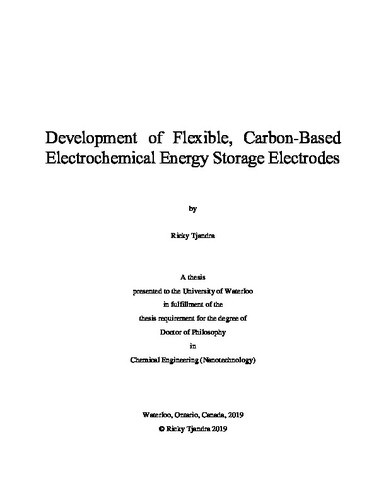| dc.description.abstract | Research into energy storage and conversion technologies has skyrocketed within the past few decades, motivated by the increased energy demands of our society and the threat of depleting energy sources. One of the exciting forefronts of energy storage research is the development of flexible electrochemical energy storage systems. This area of active research is fueled by the popularity of the Internet-of-Things (IOT), smart wearables/clothing and flexible electronics. A distinct lack of commercially available electrochemical energy storage options that can be flexed, bent, stretched and twisted is currently available to power these devices. Instead, most of today’s flexible electronic and wearables rely on rigid cell formats such as cylindrical and prismatic cells. The problem of flexible energy storage devices can be broken down into 2 deficiencies: the lack of flexible electrodes that can match the performance of their rigid counterparts and the lack of high-performance solid-state electrolytes. Carbon-based materials, especially nanoscale materials such as graphene, are a potential solution to this problem due to their electronic conductivity, relative abundance, energy storage capabilities, and ability to be used in all parts of the energy storage system.
All the work presented in this thesis involves the development and applications of carbon-based materials for flexible electrochemical energy storage systems. This thesis will explore two different pathways of achieving flexible electrodes based on carbon-based materials:
- Replacement of non-flexible metal foil current collectors using flexible carbon-based current collectors
- Elimination of current collectors and binders by using carbon-based, free-standing materials
Firstly, this thesis will explore the use of carbon cloth as a substrate for a novel TiO2 nanocrystal material for use as an anode in flexible lithium-ion supercapacitors. Although lithium-ion supercapacitors are the focus of this study, the same composite material can also be used as an anode in traditional lithium-ion batteries. The resulting carbon cloth/TiO2 composite is able to withstand 100 flexion cycles while still retaining its energy storage capabilities, showing the advantage of the carbon cloth as a substrate when compared to traditional metal foils. The composite is also successfully integrated into a flexible pouch cell that delivers an excellent reversible capacity of 270 mAh g-1. This work establishes that carbon cloth can be used to replace metal foils as a flexible current collector without sacrificing electrochemical performance.
Secondly, this thesis explores the use of a nitrogen-rich carbon foam based on the carbonization of melamine formaldehyde and graphene oxide for use in lithium-ion hybrid capacitors. The foam presented here can be used as-is as a flexible, free-standing, binder-free anode for lithium-ion hybrid capacitors/batteries. Furthermore, the foam can also be used as a 3-dimensional current collector for other active materials both in the anode and the cathode, which demonstrates its versatility for electrochemical energy storage systems. An all-carbon based lithium-ion hybrid supercapacitor has been fabricated using the foam as both an active material for the anode and the current collector for the activated carbon cathode. The cell shown in this chapter achieved an energy density of 40 Wh kg-1 which is superior to that reported in the literature that are based purely on carbon materials. The work presents a novel carbon-based flexible electrode material and concept device that also enables the removal of binders and current collectors from traditional batteries and supercapacitors, bringing us one step closer to achieving a fully flexible electrochemical energy storage system.
Finally, graphene quantum dots (GQDs) have been synthesized using a simple peroxide-assisted method. The GQDs are then electrodeposited onto carbon cloth to make an all-carbon, binder-free, flexible electrode for supercapacitors. This work builds off the TiO2/carbon cloth composite by replacing the TiO2 with a carbon-based nanomaterial. Presently reported research has involved the use of GQDs either in conjunction with another active material or used as an active material on rigid, planar substrates. We have shown that GQDs can function as a stand-alone active material for EDLC capacitors. At the time of writing, this work shows the first such use of GQDs on a non-planar, flexible substrate for supercapacitors.
All the work in this thesis centers around the use of carbon-based materials and their composites towards the development of flexible electrodes for lithium-ion batteries, supercapacitors and their hybrids. This thesis provides insights into the viability of using various carbon-based materials in different aspects of flexible electrodes and provides a basis for future investigations into this topic.
| en |

